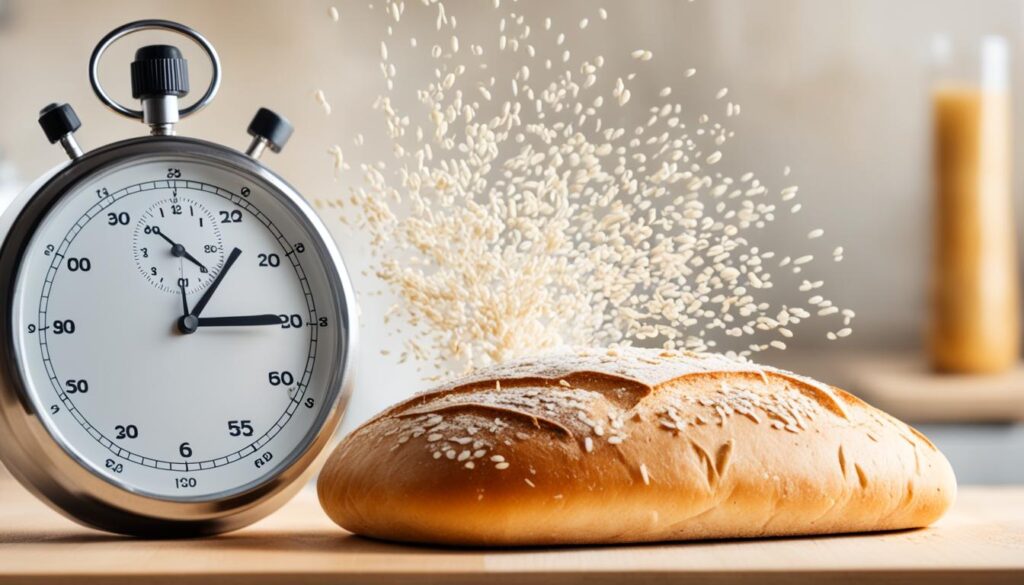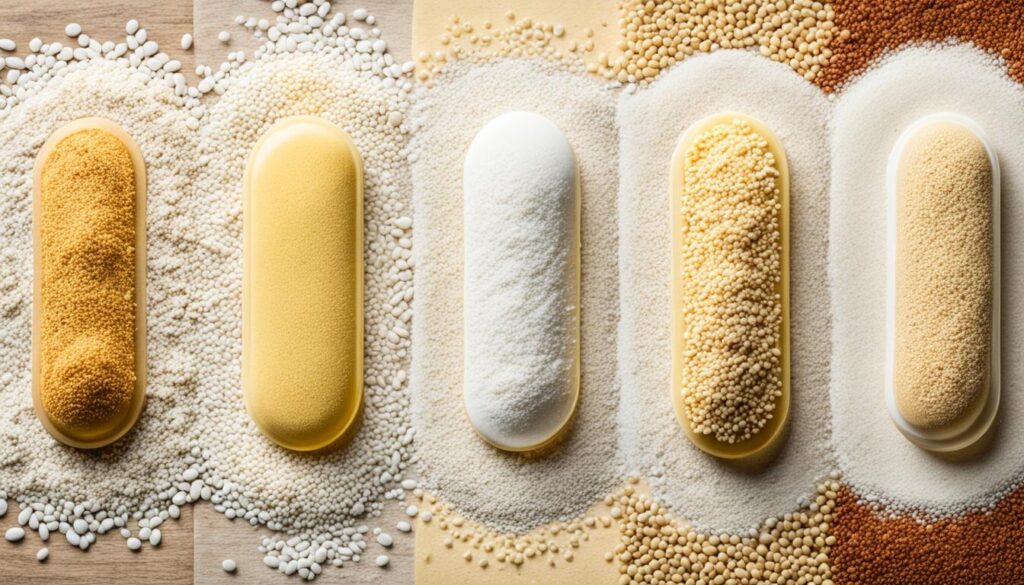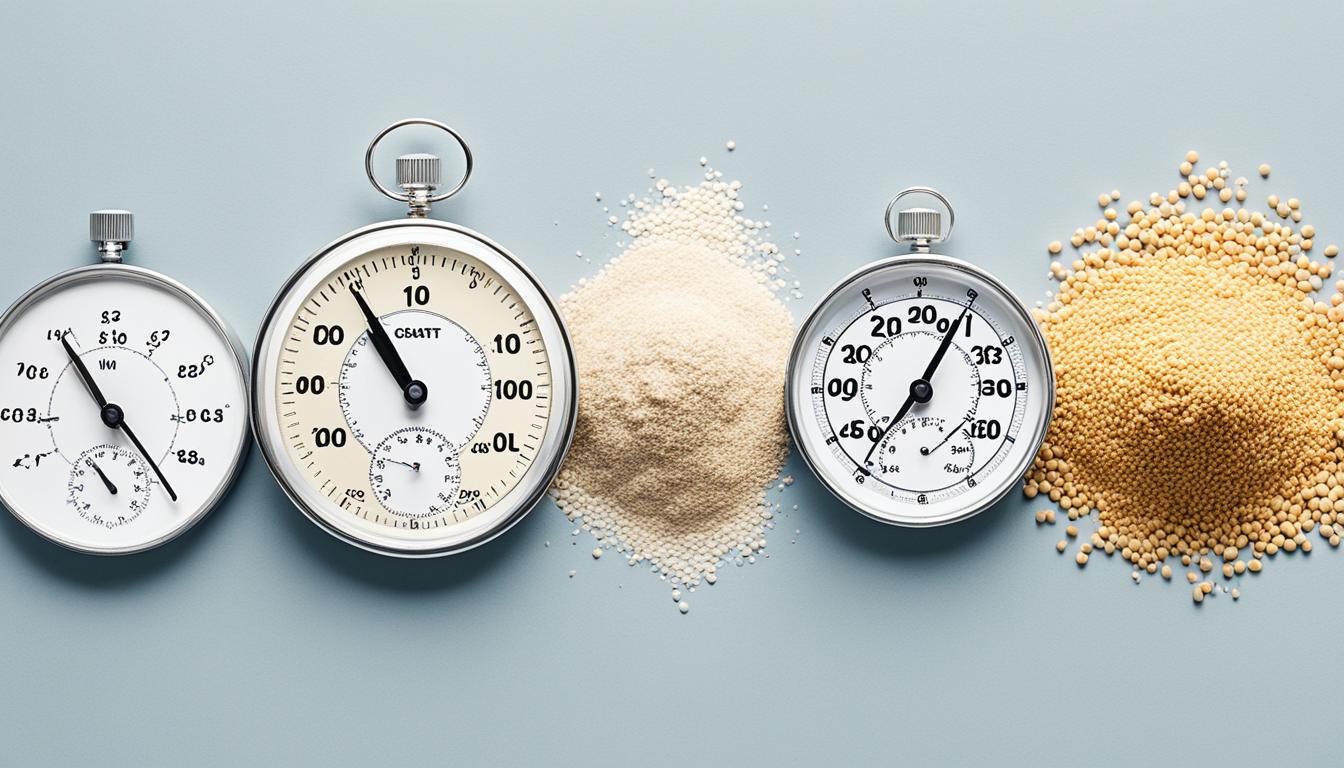Have you ever wondered what makes your homemade bread rise and become fluffy and delicious? The answer lies in a tiny yet mighty ingredient: dry yeast. But did you know that there are different types of dry yeast, each with its own unique characteristics? Let’s dive into the world of dry yeast and discover the differences between instant, active, and fast-acting yeast.
Understanding the various types of dry yeast is essential for achieving the best results in your baking endeavors. Whether you’re a seasoned baker or just starting out, knowing which yeast to use can make a significant difference in the final outcome of your bread, rolls, or other yeast-raised treats.
In this article, we will explore the benefits of each type of dry yeast, learn how to use them effectively, and discover the best practices for incorporating dry yeast into your recipes. So, grab your apron and let’s embark on a yeast-filled journey that will elevate your baking game!
Key Takeaways:
- There are different types of dry yeast, including instant, active, and fast-acting yeast.
- Instant yeast does not require activation and works quickly, making it a convenient choice for many recipes.
- Active dry yeast requires activation before use and is suitable for recipes that require multiple rises.
- Fast-acting yeast is a subcategory of instant yeast and is specifically designed for same-day baking and bread machines.
- Choosing the right yeast for your recipe is crucial for achieving the desired results.
Understanding Active Dry Yeast
Active dry yeast is a popular type of dry yeast used in baking. Brands like SAF Red Label and Dr. Oetker offer high-quality options for home bakers. But what exactly is active dry yeast and how does it differ from other types? Let’s dive in and explore the ins and outs of active dry yeast.
Activation Process:
Unlike instant yeast, active dry yeast requires activation before use. To activate active dry yeast, you need to dissolve the granules in warm water. This process rehydrates the yeast and gets it ready for action. It’s important to verify if the yeast is still alive before using it, as inactive yeast packets may be encountered sometimes.
TIP: Check the expiration date of your active dry yeast to ensure its potency.
Usage Benefits:
Active dry yeast offers certain benefits in baking. It is suitable for recipes that require more than one rise, allowing you to create bread with excellent texture and flavor. It is also compatible with cold-proofed doughs, giving you more flexibility in your baking process.
Although active dry yeast is not commonly used in professional settings due to its instability and time-consuming rehydration process, it remains a popular choice among home bakers for its versatility and availability.
Now that we have a better understanding of active dry yeast, let’s move on to exploring instant yeast, another popular type of dry yeast.
The Benefits of Active Dry Yeast:
- Allows for longer fermentation periods in recipes.
- Works well in cold-proofed doughs.
- Easy availability for home bakers.
Exploring Instant Yeast
Instant yeast, also known as quick-rise or fast-acting yeast, is a versatile and convenient option for baking. It offers numerous benefits and is straightforward to use. Whether you’re a beginner or an experienced baker, instant yeast can help you achieve excellent results with your recipes.
One of the key advantages of instant yeast is that it does not require activation. Unlike active dry yeast, which needs to be dissolved in water, instant yeast can be added directly to the dry ingredients. This saves time and eliminates the need for any additional steps.
Instant yeast works faster than other types of yeast, including active dry yeast. It has an initial speed equivalent to rapid-acting yeast. This means that your dough will rise more quickly, allowing you to enjoy your baked goods in less time. Instant yeast is particularly suitable for recipes that require a single rise.
It is important to note that instant yeast is not recommended for refrigerated doughs. Unlike other types of yeast, instant yeast does not perform well in cold temperatures. Therefore, it is best to use alternative yeasts, such as active dry yeast, when working with refrigerated doughs.
Another benefit of instant yeast is its cost-effectiveness. When stored properly, a pound of instant yeast can last for a long time. This makes it a budget-friendly choice for home bakers who frequently use yeast in their recipes.
To ensure the longevity of your instant yeast, store it in an airtight container in a cool, dry place or in the freezer. This will help preserve its freshness and effectiveness over time.
Overall, instant yeast is a reliable and convenient option for baking. Its ease of use, faster action, and cost-effectiveness make it a popular choice among home bakers. Whether you’re making bread, rolls, or pizza dough, instant yeast can enhance the quality and efficiency of your baking endeavors.
Comparison of Yeast Types
| Type of Yeast | Activation Required | Speed of Action | Suitable Recipes |
|---|---|---|---|
| Instant Yeast | No | Fast | Recipes with single rise |
| Active Dry Yeast | Yes | Slower than instant yeast | Recipes with multiple rises, refrigerated doughs |
| Fast-Acting Yeast | No | Fast, similar to instant yeast | Bread machine recipes, same-day baking |
The Advantages of Instant Yeast
When it comes to baking, instant yeast offers several advantages over active dry yeast. Let’s take a closer look at why instant yeast is a fantastic choice for home bakers.
1. No Proofing Required
One of the biggest advantages of instant yeast is that it eliminates the need for proofing. Unlike active dry yeast, which requires rehydration in warm water, instant yeast can be added directly to the dry ingredients. This saves you valuable time and effort in the baking process.
2. Faster Rising Times
Instant yeast is designed to work faster than active dry yeast. It contains a higher concentration of active yeasts, allowing the dough to rise more quickly. This is particularly beneficial for recipes that require shorter fermentation times or same-day baking.
3. Cost-Effective
Using instant yeast can be more cost-effective in the long run. While packets of active dry yeast may seem cheaper initially, a pound of instant yeast can yield many more loaves of bread. When comparing the cost per loaf, instant yeast is a more economical choice.
4. Easy Substitution
If your recipe calls for active dry yeast and you only have instant yeast on hand, don’t worry! Instant yeast can be substituted 1:1 for active dry yeast in most recipes. The only adjustment you may need to make is slightly reducing the rise time to accommodate the faster action of instant yeast.
5. Versatility and Reliability
Instant yeast is a versatile and reliable choice for a wide range of baking projects. Whether you’re making bread, rolls, pizza dough, or sweet breads, instant yeast can deliver consistent results. Its performance is consistent and dependable, making it a favorite among both home bakers and professionals.
So, if you’re looking for convenience, speed, cost-effectiveness, and reliability in your baking endeavors, instant yeast is the way to go!

| Advantages | Instant Yeast | Active Dry Yeast |
|---|---|---|
| No proofing required | ✓ | ✗ |
| Faster rising times | ✓ | ✗ |
| Cost-effective | ✓ | ✗ |
| Easy substitution | ✓ | ✓ |
| Versatility and reliability | ✓ | ✓ |
Fast-Acting Instant Yeast
When it comes to baking with yeast, fast-acting instant yeast is a game-changer. Also known as RapidRise or Quick-Rise yeast, this type of yeast offers unique advantages that make it a favorite among home bakers. Unlike other types of yeast that require a long rise time, fast-acting instant yeast is formulated to work on an accelerated timetable, saving you precious time in the kitchen.
Fast-acting instant yeast is a subcategory of instant yeast. It is specifically designed to be used in recipes that call for bread machines, where a quick rise is desired. This type of yeast allows you to enjoy freshly baked bread in a fraction of the time.
One of the key things to keep in mind when using fast-acting instant yeast is that recipe instructions may not provide specific rise times. Instead, you’ll need to rely on visual cues to determine when your dough has risen enough. This requires a bit of experience and practice, but once you get the hang of it, you’ll be able to confidently use fast-acting yeast in your favorite recipes.
Experienced bakers may also attempt to substitute different types of yeast in their recipes, including fast-acting yeast. However, for beginners, it is recommended to stick with the specific yeast called for in the recipe. This ensures consistent and reliable results, especially when it comes to rise times and texture.
If you’re looking for a method that can save you time without compromising on the quality of your baked goods, fast-acting instant yeast is the way to go. Its fast-acting nature allows you to enjoy freshly baked bread in a fraction of the time, making it perfect for busy bakers who want quick and delicious results.

| Advantages of Fast-Acting Instant Yeast |
|---|
| 1. Quick rise times |
| 2. Perfect for bread machines |
| 3. No specific rise time instructions |
| 4. Experienced bakers can substitute with adjustments |
Choosing the Right Yeast for Your Recipe
When it comes to baking, choosing the right type of yeast can make a significant difference in the final outcome of your recipe. Different yeasts have distinct properties and advantages that cater to specific baking needs. Understanding the specific yeast called for in a recipe is crucial for achieving the desired results.
Active dry yeast and instant yeast are two common types of yeast used in baking. Active dry yeast is best suited for longer fermented doughs, while instant yeast is ideal for same-day baking. Let’s take a closer look at these variations:
Active Dry Yeast
Active dry yeast requires rehydration before use and is commonly used for traditional bread recipes that involve multiple rises. It is shelf-stable and needs to be dissolved in warm water to activate its fermentation process. Brands like SAF Red Label and Dr. Oetker are popular choices for active dry yeast.
Instant Yeast
Instant yeast, on the other hand, is ready to use right out of the package. Also known as quick-rise or fast-acting yeast, it can be directly added to the dry ingredients without rehydration. Instant yeast works faster than active dry yeast and is suitable for recipes that require a single rise. SAF Red Label is a versatile instant yeast brand widely used by home bakers.
Both active dry yeast and instant yeast are readily available and can be substituted for each other with slight adjustments in rise time. However, it is recommended to use the yeast specified in the recipe to ensure consistent and successful results.
Here’s a comparison table to help you understand the differences between active dry yeast and instant yeast:
| Yeast Type | Usage | Activation | Rise Time |
|---|---|---|---|
| Active Dry Yeast | Longer fermented doughs | Requires rehydration in warm water | Longer rise time |
| Instant Yeast | Same-day baking | No rehydration required | Shorter rise time |
As you can see, choosing the right yeast for your recipe depends on the specific requirements and timeframe of your baking project. However, instant yeast, such as SAF Red Label, is a versatile choice for its shelf life, stability, and ease of use in home baking.

Benefits of Using Instant Yeast
When it comes to baking, using instant yeast offers numerous benefits for both home bakers and professional settings. Let’s explore the advantages of incorporating instant yeast into your recipes.
Simplicity and Convenience
One of the primary advantages of instant yeast is its simplicity of use. Unlike other types of yeast, instant yeast can be added directly to the dry ingredients without the need for dissolving or proofing. This saves time and effort in the baking process, allowing you to focus on creating delicious treats.
Faster Rise Times
Instant yeast works faster compared to other yeast varieties, resulting in quicker rise times for your dough. This means you can enjoy your freshly baked goods much sooner. The faster fermentation process enables you to prepare and bake your favorite recipes in a shorter amount of time.
Cost-Effective Solution
Using instant yeast can also be cost-effective in the long run. A pound of instant yeast is relatively inexpensive and can last for a significant period. This makes it a budget-friendly choice, especially for enthusiastic home bakers who frequently indulge in their passion for baking.
Long Shelf Life and Stability
A notable advantage of instant yeast is its long shelf life and stability. When stored properly, instant yeast can maintain its quality in the freezer for years. This means you can stock up on instant yeast without worrying about it losing its effectiveness over time. Having a stable supply of instant yeast ensures you’re always prepared for your baking adventures.
| Benefits of Instant Yeast |
|---|
| Simple and convenient to use |
| Faster rise times |
| Cost-effective option |
| Long shelf life and stability |
Overall, instant yeast provides a range of benefits that enhance the baking experience. Its simplicity, faster rise times, cost-effectiveness, and long shelf life make it a popular choice for bakers of all levels of expertise. Whether you’re a home baker or working in a professional setting, instant yeast can help you achieve excellent results in your baked goods.
Continue reading to learn how instant yeast can be used in various baking recipes and discover best practices for incorporating yeast into your culinary creations.
Instant Yeast in Baking Recipes
When it comes to using instant yeast in baking, the possibilities are endless. Its fast-acting nature and versatility make it an excellent choice for a wide variety of yeast-raised doughs. Whether you’re craving a classic sandwich bread, fluffy dinner rolls, homemade pizza dough, or delightful sweet breads like cinnamon rolls, instant yeast can help you achieve excellent results.
Check each recipe to see which type of yeast it recommends, and if it calls for instant yeast, you’re in luck! Simply follow the instructions and add the instant yeast directly to the dry ingredients. Its convenience and ease of use make it a favorite among home bakers.
With instant yeast, you can enjoy quicker rise times, which means less waiting and more delicious baked goods on your table. Its reliability and consistent performance make it a go-to option for both novice and experienced bakers.
So, why limit yourself? Let’s explore a few popular baking recipes that can be elevated with the use of instant yeast:
Bread
- Classic sandwich bread
- French baguettes
- Sourdough bread
Rolls and Buns
- Pull-apart butter buns
- Parker House rolls
- Cheese buns
Pizza and Flatbreads
- Thin-crust pizza dough
- Grandma pizza
- Naan bread
Sweet Breads
- Cinnamon rolls
- Soft dinner rolls
- Brioche
These are just a few examples, but the sky’s the limit when it comes to using instant yeast in baking. So, go ahead and unleash your creativity in the kitchen with confidence, knowing that instant yeast has got your back.
Remember, for each recipe, be sure to follow the recommended type of yeast and adjust accordingly. With instant yeast, you can enjoy the ease of use and reliable performance that will take your baking to new heights.
Best Practices for Using Dry Yeast
To ensure the best results when using dry yeast, it is essential to follow some best practices. Here are our top tips and recommendations for handling and using dry yeast:
- Check the expiration date: Before using dry yeast, always check the expiration date on the package. The potency of yeast can vary over time, so using fresh yeast ensures optimal results.
- Handle with care: Active dry yeast is delicate and can be easily damaged by liquids above 115°F (46°C). Be gentle when handling the yeast to maintain its integrity and effectiveness.
- Rehydrate as directed: If using active dry yeast, follow the package instructions to rehydrate it properly. Typically, this involves dissolving the granules in a portion of milk or water from the recipe. Proper hydration ensures the yeast activates and works correctly.
- Incorporate instant yeast directly: Unlike active dry yeast, instant yeast does not require rehydration. You can incorporate it directly into the dry ingredients of your recipe, saving time and effort.
- Add proofing ingredients with other liquids: If your recipe calls for additional proofing ingredients, such as sugar or honey, add them along with the other liquids in the recipe. This ensures they are evenly distributed and can activate the yeast effectively.
- Proper storage: To maximize the shelf life of dry yeast, store it in airtight containers in a cool, dry place. Alternatively, you can store it in the freezer to extend its longevity even further.
By following these best practices for using dry yeast, you can ensure consistent and successful outcomes in your baking projects.
Comparison of Different Types of Dry Yeast
| Dry Yeast Type | Activation Method | Usage |
|---|---|---|
| Active Dry Yeast | Requires rehydration in warm liquid | Suitable for recipes with multiple rises |
| Instant Yeast | No activation required | Ideal for recipes with a single rise |
| Fast-Acting Yeast | No activation required | Designed for bread machine recipes or same-day baking |
Follow the handling and usage recommendations specific to each type of dry yeast to achieve the best results in your baking endeavors.
Where to Buy Instant Active Dry Yeast
Instant active dry yeast, a key ingredient in baking, can be conveniently purchased both online and in physical stores. Here are some options for where to find this versatile yeast:
- Online Marketplaces: Online platforms like Amazon offer a wide range of instant active dry yeast options from various reputable brands. You can browse customer reviews and compare prices to make an informed purchase.
- Supermarkets and Grocery Stores: Major supermarkets and grocery stores typically stock instant yeast in the baking aisle. Look for popular brands like Fleischmann’s, Red Star, or Bob’s Red Mill.
- Specialty Baking Stores: Specialty baking stores often carry a larger selection of yeast brands and packaging sizes compared to regular grocery stores. These stores may cater to professional bakers or enthusiasts and may offer unique yeast varieties.
- Bulk Food Stores: Bulk food stores are another great option for purchasing instant yeast in larger quantities. These stores often provide cost-effective options for commercial or frequent bakers.
When buying instant active dry yeast, it is advisable to compare prices, read customer reviews, and consider factors like shelf life and packaging size. With a little research, you can find the best quality and value for your baking needs.
Conclusion
In conclusion, dry yeast is a fundamental ingredient that plays a crucial role in successful baking. By understanding the different types of dry yeast, including instant, active, and fast-acting yeast, you can achieve the desired results in your recipes. Each type of yeast offers its own advantages and has specific usage requirements.
However, instant yeast stands out as a versatile and reliable choice for home bakers. With instant yeast, there’s no need for proofing, saving you time and effort in the baking process. It also works faster, allowing your dough to rise more quickly. Additionally, instant yeast is cost-effective, making it a budget-friendly option. By following best practices and using the recommended yeast for each recipe, you can consistently create delicious baked goods.
We encourage you to experiment with different types of dry yeast to find your preferred choice for specific baking projects. Whether you’re making bread, rolls, pizza dough, or sweet breads, dry yeast will help you achieve excellent results. As you embark on your baking journey, remember to store dry yeast properly and check the expiration date to ensure optimal potency. Happy baking!
